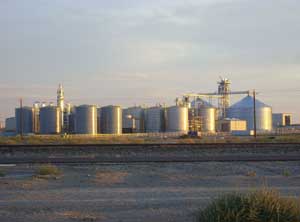In Dynamic Pursuit of Efficiency




September 8, 2008
BY Ron Kotrba
Volume is king when input costs are low but when margins collapse, it always plays second fiddle to efficiency. A perfect cook and fermentation process utilizes 100 percent of the feedstock's starch; however, as evidenced by ongoing comprehensive analyses of distillers grains, the industry is not there yet. According to the assistant research director of the National Corn-to-Ethanol Research Center, Yan Zhang, the average content of residual sugars found in distillers grains is about 8 percent on a dry-matter basis. "If an ethanol plant cannot optimize its cooking process, or if it drops the fermentor based on fermentation time instead of the extent of fermentation completion, it is very easy to have high levels of residual sugars in distillers grains," she says.
A U.K.-based company, Pursuit Dynamics PLC, is preparing to go commercial with its PDX Ethanol Reactor Tower, a device for pretreating slurry with atomized steam and pressure. Rick Eastman, president the company's U.S. subsidiary, Pursuit Dynamics Inc., says the technology was originally developed for marine power.
"It actually pumps by virtue of this annular nozzle that atomizes the steam into a flow of liquid, which causes a vacuum pressure reaction," he says. "So downstream there's a vacuum and upstream there's pressure. That causes an explosion, or cell rupture, and that's what we are seeing in our starch conversion—we are seeing more starch at less destructive temperatures than with a hydroheater, for example." The PDX ERT has applications ranging from food ingredient mixing, to fire suppression, to wort boiling and brewing, but it's the equipment's ability to boost ethanol production efficiency that is of interest.
Major test trials were conducted on the PDX ERT in December 2007 at NCERC, which is on the campus of Southern Illinois University in Edwardsville, Ill., says director John Caupert. NCERC research director Brian Wrenn oversaw the project but because of a confidentiality agreement, Wrenn could not disclose any information at press time. However, Pursuit Dynamics chief technology officer Jens Thorup presented information and data gathered from its tests at NCERC at the International Fuel Ethanol Workshop & Expo this year. First, though, EPM takes a closer look at what the reactor is and how it works.

The Inner Workings
The reactor tower is installed between the slurry and liquefaction processes of an ethanol plant. Instead of the corn being milled, slurried and pumped directly to the liquefaction tank, the slurry enters the ERT prior to passing through to liquefaction. Inside the ERT are multiple reactor modules, each equipped with individual controls to optimize the temperature profile. "To get fully dispersed phases in our reactors we like to start at a temperature well below the final liquefaction temperature, which is 185 degrees [Fahrenheit]," Eastman says. "We're at about 125 degrees, requiring minor process modifications to keep that slurry tank under the gelatinization temperature."
The ERT is positioned on the side of the liquefaction tank and, by way of vacuum, the slurry mixture moves inside the bank of reactors where highly atomized steam, coming from the conditioning chamber wrapped around the core of the reactor, is injected into the slurry stream causing impact. "That causes a fully dispersed condensation phase, which brings it back to between 12 and 15 pounds of pressure," Eastman says. "There's tremendous impact there. It happens in four stages in what's a fairly small reactor. Then there is a final heater—like a trim heater—which is a PDX nozzle, and then the slurry is deposited into the liquefaction tank." Again, the temperature of each stage is controlled through the use of automated steam valves feeding each one of the reactor banks. Through significant steam impact and material disruption there is instant activation of all of the starch, including the hard to get to intracellular starch. "What we're doing is separating all of the starch from the cellulose in the corn kernel," Eastman tells EPM.
In addition to making more starches available for downstream fermentation, the steam conditioning and low temperatures reduce so-called hotspots and starch degeneration from what's called Maillard Reaction loss. The Maillard Reaction, named for chemist Louis-Camille Maillard, who thoroughly investigated this phenomenon in the early 1900s, is a temperature-induced reaction between sugars and amino acids. It's what causes the browning of meat, for instance, when it's cooked. If the cook temperature of the slurry is too high, it may render some otherwise fermentable sugars unfermentable. Of note, on the back end of ethanol production high dryer temperatures and the Maillard Reaction are responsible for the over-browning of distillers grains, which degrades the amino acids digestibility.
Test Trials
The equipment trial conducted at NCERC was benchmarked against a conventional jet cooker. At this year's FEW Thorup presented results from data collected during the third-party evaluation testing. A 14 percent boost in ethanol yield was achieved. "That's from the added starch recovery and activation," Eastman says. In an economic environment as tight as it is today, a 14 percent increase in ethanol yield appears to be a remarkable achievement.
The pretreatment device not only improved ethanol yields by double-digit numbers, but according to Thorup it also reduced liquefaction time by 75 percent. Since the grain slurry has been significantly disrupted in the ERT prior to liquefaction, it also means that far fewer alpha amylase enzymes are needed because much of the starches have been made accessible. This allows fewer enzymes to do more. Thorup said a 50 percent reduction in alpha amylase use was documented from the NCERC trials. Lastly, he said a 30 percent reduction in fermentation time resulted from pretreating the slurry with Pursuit Dynamics' ERT.
The first full-scale production trial of the ERT is currently underway at Pacific Ethanol Inc.'s 40 MMgy plant in Boardman, Ore. Tim Raphael, communications director for Pacific Ethanol, tells EPM the testing is going well so far. In mid-August it was too early for the testing to have yielded any results but Raphael says they are all hopeful and will have hard production data once the testing is complete.
"It's a matter of installing the technology and then beginning to integrate it into the process to see what that does through the systems at the plant," Raphael says. "Then we'll be ramping things up to see what it does for production at the plant—to see how well it integrates into our process."
Eastman says while it is premature to talk about results, he says initial work at the Boardman plant indicates they are averaging a yield increase of more than 10 percent. "It's going well," he says. "Of course we've encountered some ups and downs like any trials."
It's no accident that Pacific Ethanol is the first company to test Pursuit Dynamics' ERT in a full-scale trial. "I was involved in and responsible for building and owning a portion of the first dry-grind ethanol plant in California," Eastman says. "It was built in conjunction with Western Milling." That plant is in Goshen, Calif., and has since been sold to Altra Biofuels. "A former colleague of mine, Neil Koehler, was driving Pacific Ethanol," he explains. "He discussed with me the possibility to cooperate rather than compete on some projects. So it was with Pacific Ethanol, as their director of technology, that I was introduced to Pursuit Dynamics and PDX technology."
Future Possibilities
Although there may not be many more greenfield corn-ethanol plants built in the United States, Eastman says there are tremendous retrofit possibilities. "We can walk into all of the 160 or so ethanol plants existing today and make a difference," he tells EPM. Rather than ethanol plants flat-out paying the capital expenses to buy one of these reactor towers, Eastman says the company is looking at a recurring income (i.e. royalty) model. "We'd like to share 20 percent of the benefits, so for example if the overall benefit is a dollar, we'd like 20 cents on an ongoing basis." There may be some signing costs too, but Eastman says those would be relatively low. "It's not millions of dollars by any stretch of the imagination," he says.
In addition to "generation one" enhanced starch activation, Pursuit Dynamics is also investigating how its ERT can pretreat corn fiber (generation 1.5) and second-generation feedstocks such as corn cobs. What is characterized as generation 1.5, converting corn fiber, entails conventional ethanol production utilizing the ERT between slurrying and liquefying, followed by conventional processing and distillation after which the stillage would be targeted. "We're looking at the fiber that's been taken all the way through the cook and distillation processes and attacking it again," Eastman explains. According to Thorup, ethanol yield is boosted 24 percent higher than conventional processing when using a jet cooker instead of an ERT that not only activates more starch but also "attacks" the already-processed corn fiber once again. Recycling the already-cooked material back through the production process elevates the per-unit protein and fat content in the resulting distillers grains because the cellulose and hemicellulose portions of the corn have been reduced and converted into ethanol. Impact trials on second-generation feedstocks, such as wheat straw, have also shown preliminary signs of success.
Ron Kotrba is an Ethanol Producer Magazine senior writer. Reach him at rkotrba@bbiinternational.com or (701) 738-4942.
A U.K.-based company, Pursuit Dynamics PLC, is preparing to go commercial with its PDX Ethanol Reactor Tower, a device for pretreating slurry with atomized steam and pressure. Rick Eastman, president the company's U.S. subsidiary, Pursuit Dynamics Inc., says the technology was originally developed for marine power.
"It actually pumps by virtue of this annular nozzle that atomizes the steam into a flow of liquid, which causes a vacuum pressure reaction," he says. "So downstream there's a vacuum and upstream there's pressure. That causes an explosion, or cell rupture, and that's what we are seeing in our starch conversion—we are seeing more starch at less destructive temperatures than with a hydroheater, for example." The PDX ERT has applications ranging from food ingredient mixing, to fire suppression, to wort boiling and brewing, but it's the equipment's ability to boost ethanol production efficiency that is of interest.
Major test trials were conducted on the PDX ERT in December 2007 at NCERC, which is on the campus of Southern Illinois University in Edwardsville, Ill., says director John Caupert. NCERC research director Brian Wrenn oversaw the project but because of a confidentiality agreement, Wrenn could not disclose any information at press time. However, Pursuit Dynamics chief technology officer Jens Thorup presented information and data gathered from its tests at NCERC at the International Fuel Ethanol Workshop & Expo this year. First, though, EPM takes a closer look at what the reactor is and how it works.

The Inner Workings
The reactor tower is installed between the slurry and liquefaction processes of an ethanol plant. Instead of the corn being milled, slurried and pumped directly to the liquefaction tank, the slurry enters the ERT prior to passing through to liquefaction. Inside the ERT are multiple reactor modules, each equipped with individual controls to optimize the temperature profile. "To get fully dispersed phases in our reactors we like to start at a temperature well below the final liquefaction temperature, which is 185 degrees [Fahrenheit]," Eastman says. "We're at about 125 degrees, requiring minor process modifications to keep that slurry tank under the gelatinization temperature."
The ERT is positioned on the side of the liquefaction tank and, by way of vacuum, the slurry mixture moves inside the bank of reactors where highly atomized steam, coming from the conditioning chamber wrapped around the core of the reactor, is injected into the slurry stream causing impact. "That causes a fully dispersed condensation phase, which brings it back to between 12 and 15 pounds of pressure," Eastman says. "There's tremendous impact there. It happens in four stages in what's a fairly small reactor. Then there is a final heater—like a trim heater—which is a PDX nozzle, and then the slurry is deposited into the liquefaction tank." Again, the temperature of each stage is controlled through the use of automated steam valves feeding each one of the reactor banks. Through significant steam impact and material disruption there is instant activation of all of the starch, including the hard to get to intracellular starch. "What we're doing is separating all of the starch from the cellulose in the corn kernel," Eastman tells EPM.
In addition to making more starches available for downstream fermentation, the steam conditioning and low temperatures reduce so-called hotspots and starch degeneration from what's called Maillard Reaction loss. The Maillard Reaction, named for chemist Louis-Camille Maillard, who thoroughly investigated this phenomenon in the early 1900s, is a temperature-induced reaction between sugars and amino acids. It's what causes the browning of meat, for instance, when it's cooked. If the cook temperature of the slurry is too high, it may render some otherwise fermentable sugars unfermentable. Of note, on the back end of ethanol production high dryer temperatures and the Maillard Reaction are responsible for the over-browning of distillers grains, which degrades the amino acids digestibility.
Test Trials
The equipment trial conducted at NCERC was benchmarked against a conventional jet cooker. At this year's FEW Thorup presented results from data collected during the third-party evaluation testing. A 14 percent boost in ethanol yield was achieved. "That's from the added starch recovery and activation," Eastman says. In an economic environment as tight as it is today, a 14 percent increase in ethanol yield appears to be a remarkable achievement.
The pretreatment device not only improved ethanol yields by double-digit numbers, but according to Thorup it also reduced liquefaction time by 75 percent. Since the grain slurry has been significantly disrupted in the ERT prior to liquefaction, it also means that far fewer alpha amylase enzymes are needed because much of the starches have been made accessible. This allows fewer enzymes to do more. Thorup said a 50 percent reduction in alpha amylase use was documented from the NCERC trials. Lastly, he said a 30 percent reduction in fermentation time resulted from pretreating the slurry with Pursuit Dynamics' ERT.
The first full-scale production trial of the ERT is currently underway at Pacific Ethanol Inc.'s 40 MMgy plant in Boardman, Ore. Tim Raphael, communications director for Pacific Ethanol, tells EPM the testing is going well so far. In mid-August it was too early for the testing to have yielded any results but Raphael says they are all hopeful and will have hard production data once the testing is complete.
"It's a matter of installing the technology and then beginning to integrate it into the process to see what that does through the systems at the plant," Raphael says. "Then we'll be ramping things up to see what it does for production at the plant—to see how well it integrates into our process."
Eastman says while it is premature to talk about results, he says initial work at the Boardman plant indicates they are averaging a yield increase of more than 10 percent. "It's going well," he says. "Of course we've encountered some ups and downs like any trials."
It's no accident that Pacific Ethanol is the first company to test Pursuit Dynamics' ERT in a full-scale trial. "I was involved in and responsible for building and owning a portion of the first dry-grind ethanol plant in California," Eastman says. "It was built in conjunction with Western Milling." That plant is in Goshen, Calif., and has since been sold to Altra Biofuels. "A former colleague of mine, Neil Koehler, was driving Pacific Ethanol," he explains. "He discussed with me the possibility to cooperate rather than compete on some projects. So it was with Pacific Ethanol, as their director of technology, that I was introduced to Pursuit Dynamics and PDX technology."
Future Possibilities
Although there may not be many more greenfield corn-ethanol plants built in the United States, Eastman says there are tremendous retrofit possibilities. "We can walk into all of the 160 or so ethanol plants existing today and make a difference," he tells EPM. Rather than ethanol plants flat-out paying the capital expenses to buy one of these reactor towers, Eastman says the company is looking at a recurring income (i.e. royalty) model. "We'd like to share 20 percent of the benefits, so for example if the overall benefit is a dollar, we'd like 20 cents on an ongoing basis." There may be some signing costs too, but Eastman says those would be relatively low. "It's not millions of dollars by any stretch of the imagination," he says.
In addition to "generation one" enhanced starch activation, Pursuit Dynamics is also investigating how its ERT can pretreat corn fiber (generation 1.5) and second-generation feedstocks such as corn cobs. What is characterized as generation 1.5, converting corn fiber, entails conventional ethanol production utilizing the ERT between slurrying and liquefying, followed by conventional processing and distillation after which the stillage would be targeted. "We're looking at the fiber that's been taken all the way through the cook and distillation processes and attacking it again," Eastman explains. According to Thorup, ethanol yield is boosted 24 percent higher than conventional processing when using a jet cooker instead of an ERT that not only activates more starch but also "attacks" the already-processed corn fiber once again. Recycling the already-cooked material back through the production process elevates the per-unit protein and fat content in the resulting distillers grains because the cellulose and hemicellulose portions of the corn have been reduced and converted into ethanol. Impact trials on second-generation feedstocks, such as wheat straw, have also shown preliminary signs of success.
Ron Kotrba is an Ethanol Producer Magazine senior writer. Reach him at rkotrba@bbiinternational.com or (701) 738-4942.
Advertisement
Advertisement
Advertisement
Advertisement
Upcoming Events





